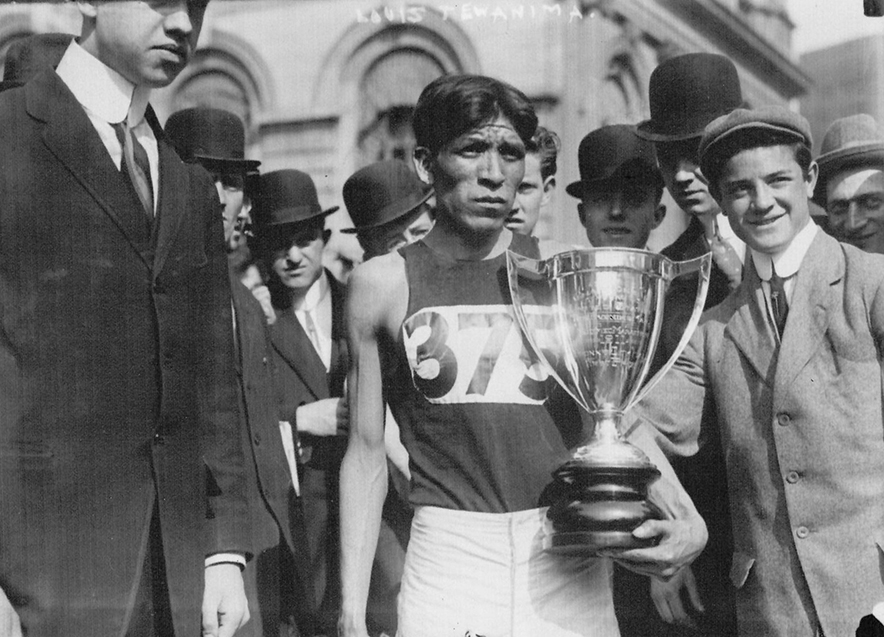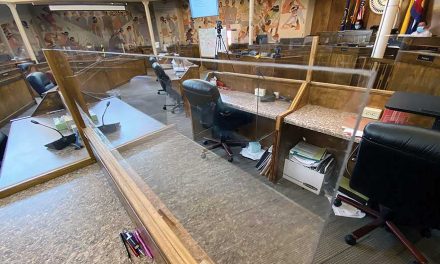
Hopi prepares for 50th annual Louis Tewanima Footrace

Courtesy Photo | Rosanda Suetopka Thayer
Hopi runner Tewanima Footrace won the silver medal in the 10K race at the 1912 Olympics in Stockholm, Sweden. The Hopi tribe is preparing to host the 50th Annual Louise Tewanima Footrace to honor the legacy of the Hopi Olympian.
CHINLE
It has been 111 years since Hopi long distance runner Louis Tewanima captured the Silver Medal at the 1912 Olympics in Stockholm, Sweden. He earned the medal in the 10,000 meters, competing against the top runners in the world.
In 1973, the first Louis Tewanima Footrace was staged by the Hopi Tribe in honor of their hometown Olympic hero. Five decades later, the annual run has escalated into a world-renown event and attracts runners from across the world.
This coming Labor Day, September 3, will be the 50th year of the annual Louis Tewanima Footrace, a 5K and 10K race event that honors Hopi athlete Louis Tewanima.
President of the Louis Tewanima Foundation, Ron Milford, said that he and his team are thrilled as they reach this milestone in the race’s history. He said it is an event that represents unity, resilience and cultural pride.
“We originally put this on to honor the legacy of Tewanima’s running career as a Hopi runner, and to maintain the legacy of his achievement,” said Milford. “It was such an honor to have an Olympic runner come from this village [Second Mesa], a Native American Olympian.”
Media correspondent for the event, Rosanda Suetopka Thayer, is helping the committee put together this year’s race and she said it’s an honor to help organize this 50-year annual event.
The race will take place at Second Mesa, Arizona, with the courses taking runners through the beautiful desert landscape and up and down the mesa.
“The run itself, is on one of the genuine, historic Hopi sandy mesa dirt trails which will test any professional runner either Native or non-Native since it does go up and down the mesa edge and through areas of Hopi that have super sandy soil,” Thayer said.
“I really doubt there is any other formal run event in the United States that can say, the runners will compete on a ‘historic, genuine tribal reservation mesa top trail.”’
The race is to honor Hopi’s first Olympian and to share their Hopi culture and values with visitors who come from around the world to participate. This is one of the few racing events where modern athleticism and cultural heritage can come together and be celebrated.
It is also a time for the Hopi people to reflect on their cultural values and remember the life and achievements of Tewanima.
Tewanima, refusing to forget his Hopi heritage, was sent by the U.S. Government to Fort Wingate, N.M. in 1906 and then to Carlisle Indian Industrial School in Carlisle, Pennsylvania for “reeducation,” in 1907.
While there he met his coach, Glenn S. “Pop” Warner, who helped Tewanima become a long-distance running champion. He also became teammates with Jim Thorpe and won numerous long-distance races.
Tewanima represented the Hopi Nation and the United States at the 1908 Olympics in London, England, and then again in the 1912 Olympics in Stockholm, Sweden.
It was in Sweden that Tewanima won silver in the 10,000-meter run, setting a U.S. Olympic record that would stand until 1964.
That record was broken by Billy Mills of the Oglala Lakota tribe, who captured the Gold Medal in the 10,000-meter run at the 1964 Tokyo Olympics in Japan
Tewanima then returned home to Second Mesa where he would continue helping his tribe and become a respected elder.
“Despite going to that run and going to Europe and running and all that, he came home and retired from running and he assumed his traditional way of life,” Milford said. “That also speaks a lot about how important for him to be, you know, Hopi, living his way of life after all that he achieved.”
Tewanima represented his native people during a time when natives were segregated and underrepresented. His actions broke barriers and gave a glimpse of what Hopi and other Native Americans are capable of.
Milford believes Tewanima’s story still serves as a source of inspiration, and a legacy that can still be related to today as he referenced Hopi Junior and Senior High’s cross country 27-year win streak, a national record.
The night before the annual Tewanima footrace, many of the runners will have gather and eat traditional Hopi dishes before the run the next day. Thayer remembers one year meeting different people from all walks of life who came to patriciate in the race for different reasons.
She met an Australian who heard about the race through one of his running clubs.
“He said he always wanted to come to a genuine Indian reservation but was hoping to have a deeper visit than just sightseeing…he felt this run was a way for him to connect with Hopi land. He said it was his first time to Hopi and he is planning on being here again this year,” Thayer said.
Another runner was from Utah and he and his family were camping the night before the race.
“He said it was a ‘lifetime’ experience to really see and understand how Hopi have survived and endured all these thousands of years. He said he couldn’t believe how high up the mesa was and he was excited to be on a historic trail for this event,” Thayer said.
A third man was just passing through Tuba City when he saw a flyer for the race and decided to give it a shot.
“He said he had no idea what the trail would be like, but he was looking forward to seeing how he fared in a natural mesa top setting,” she said.
There are only 300 slots open for the event and until the end of July, entry for the 10K event is $55 and entry for the 5K is $45. After July 31, the prices will increase. Event prizes include traditional Hopi art that will be given to the top race finishers.
Participants can sign up online and are encouraged to visit Tewanima footrace.org to get important information on the race’s course, rules and other pertinent details.
Milford said money from the race will go to the Hopi Education Endowment and other educational opportunities to help fund scholarships for local students.








 Highway 264,
Highway 264, I-40, WB @ Winslow
I-40, WB @ Winslow